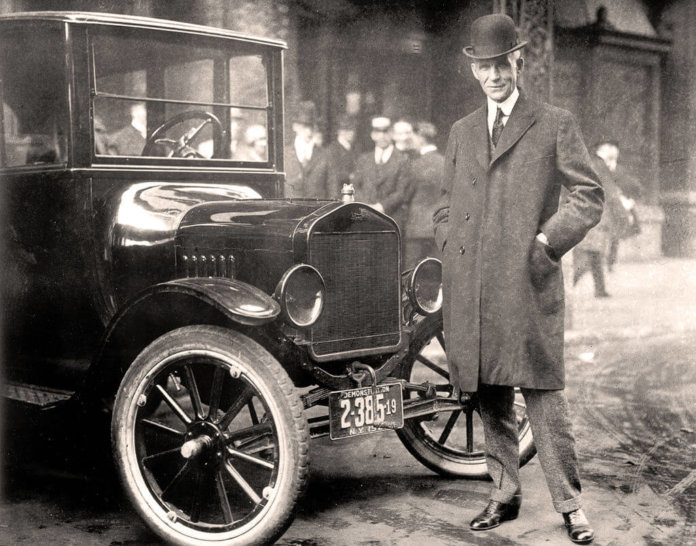
The Ford Motor Company is not just one of the world’s industrial icons, but is also one of the most successful examples of a family-owned business. With fifth generation Fords still actively involved in the firm, including current Chairman William Clay Ford Jr, the family has done something very few have been able to replicate. After all, it is extremely rare for a family owned business to pass on leadership of the company beyond two or three generations, with John Davis, a Harvard Business School professor, claiming that only 1% to 2% of businesses survive to the third generation.
So how has the Ford family been able to stay on top for 113 years as one of the world’s biggest automotive companies? The answer lies in a hybrid ownership model that serves as a textbook example for large family-owned corporations everywhere.
The Man Who Started It All
Ford is named after its founder Henry Ford, who is perhaps just as well known in American history for his role in revolutionizing the automotive industry. Yet, he was not exactly a model of success from the beginning – in fact, Ford Motor Company was not Henry’s Ford’s first car company, but his third, after his less-than-successful initial attempts.
Despite the failures, Ford was driven by a vision, a vision that he recounted in 1913:
“I will build a motor car for the great multitude. It will be large enough for the family but small enough for the individual to run and care for. It will be constructed of the best materials, by the best men to be hired, after the simplest designs that modern engineering can devise. But it will be so low in price that no man making a good salary will be unable to own one—and enjoy with his family the blessings of hours of pleasure in God’s great open spaces.”
It was this dedication to bring automobile production to the masses that set Henry Ford apart. Though others such as Karl Benz were credited with inventing the first practically operating automobile, it was Ford’s famous invention of the assembly line and the resulting Model T that introduced the first cheap, easy-to-drive car to the world. The Model T only cost $825 in 1908 ($21,760 today), and in 10 years, the majority of Americans had learned how to drive the car.
But Ford’s innovations didn’t stop there. He stunned the industrial world when he began offering double the going wage for skilled labourers. The concept, which today is referred to as “Fordism”, is rooted in Ford’s conviction that the company would mass-produce low cost goods that his workers would also be able to purchase. Ford had the foresight to see that the money invested in highly skilled labour would increase productivity and reduce the amount of time and money spent on training, and this concept became the very foundation of the model of economic expansion and technological progress based on mass production that the American economy went on to embody.
The Next Generation
After years of trailblazing work, Ford handed the reins to his only child, Edsel, in 1919. By 1921, just two years into Edsel’s tenure as CEO, half of the cars on the road in America were Model T’s. Edsel oversaw a steady and stable growth period for the company for twenty years until he tragically passed away from cancer in 1943.
An aged and heartbroken Henry Ford briefly took back the company’s leadership after his son’s untimely death but eventually stepped aside for his grandson Henry Ford II in 1945. Henry Ford II would oversee the company for 15 years during which the company would undergo it’s biggest restructuring to date.
A Hybrid Ownership Model
In January 1956, The Ford Motor Company became a publicly traded company, marking the first time the company was not solely owned by the Fords since its inception. This was the beginning of the hybrid ownership approach that continues even to today, in which the Fords own a large chunk of the company and have influence on its board but do not control its day-to-day operations. Today the Ford family wields its influence through Class B super-voting stock that gives them 40% of the common stock vote.
The new governance system was not unlike what one of the world’s oldest and most successful families, the Merricks, did to help their own corporation thrive. The Merricks established a unique dual-board system whereby the management is controlled by a board consisting of predominantly non-family members, while a family-only board acts in a supervisory capacity for the management board. Though the model employed by the Fords has not gone this far with the formal structure, the combination of family roots and outside perspective has been proven successful. As William Clay Ford Jr. explains, “They know there is going to be someone there through thick and thin who isn’t going to take a golden parachute and run somewhere,” he said in a Wall Street Journal interview as he describes the key behind his company’s stability.
With Ford today enjoying some of its best sales years and seeing its share price rise by more than 50% it is clear that the generations of Fords that have lead and will lead the company into the future will prove to be a source of stability in the American economy for generations to come.









